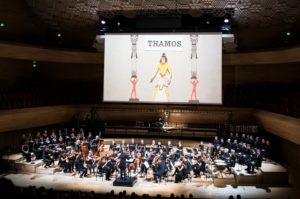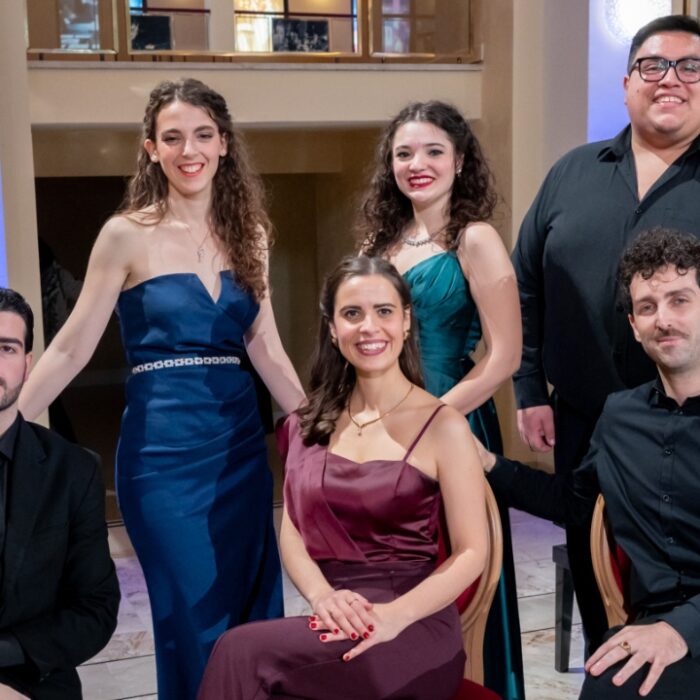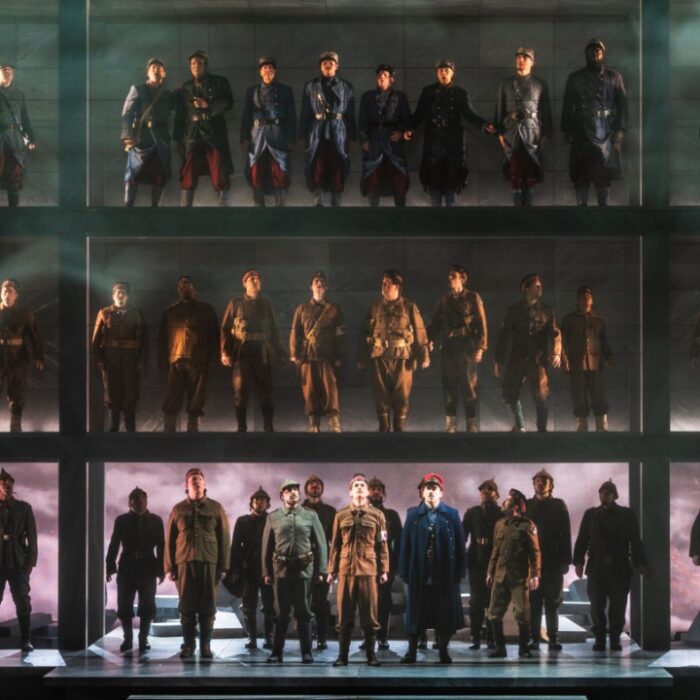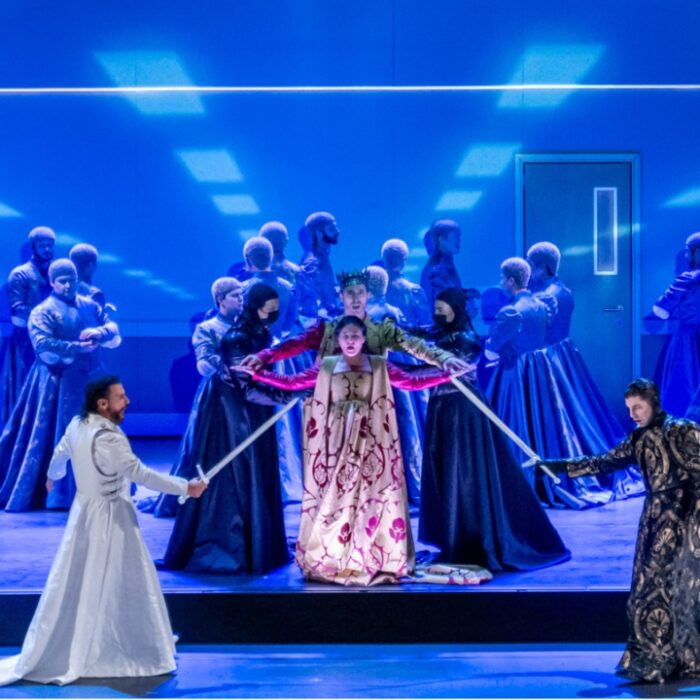
Insula Orchestra Paris 2017-18 Review: Thamos, König in Ägypten
Mozart Rarity Given An Inspired Revival At La Seine Musicale
By Jonathan SutherlandEarly Music ensembles have a remarkable ability to think up the most exotic names for themselves. Il giardino armonico, Il pomo d’oro, Les Arts Florissants or Marinka Brecelj’s Fiori Musicali all have a horticultural perfume about them. Others reek of “après moi le deluge” regal panoply with the King’s Consort or La Grande Écurie et la Chambre du Roy taking the Cordon Bleu.
In marked contrast, the period instrument Insula Orchestra founded in 2012 by Laurence Equilbey is far from self-effacing as the name may imply. Similarly, “Insula” should not be thought of as some Francophone adaptation of ‘insular” with its inapposite definition of “uninterested in cultures, ideas, or peoples”. The significance of “Insula” is actually a topographical reference to the ensemble’s new home in the spectacular La Seine Musicale concert hall located on the Île Seguin about 8 kilometers west of Paris by Boulogne-Billancourt. Opened only last year, La Seine Musicale is already presenting regularly sold-out events on its Elysian island.
A former Renault car production plant, all traces of trimethylbenzene and sump oil have been successfully eradicated and the behemothic egg cum Christmas bauble structure dominates the river as if an enormous cruise ship with a whopping ellipsoidal observation bubble plopped onto the prow had run aground. Enforcing the maritime concept, the striking spherical glass and spruce wood lattice façade of the ovaloid is wrapped in a photovoltaic sail, which moves with the sun’s path and provides solar energy for the entire 2.3 hectare site. The award-winning exterior by Shigeru Ban and Jean de Gastines is much more striking than the rather bland 1,200-seat concert hall, which was yet another project by the ubiquitous Yasuhisa Toyota, this time with the input of local sound boffins Lamoureaux Acoustics. Unlike the NOSPR hall in Katowice or the recently renovated Auditorium de Radio France down the river, the end result is overly dry with a nanosecond reverb although the baroque posaunes sounded wonderful. The interior ambience is closer to a birchy conference center than a resonant, welcoming Mecca for music.
Early Mozart
In keeping with her penchant for delving into early Mozart, French maestro Laurence Equilbey presented the “Litaniae de venerabili altaris sacramento” K.243 written in 1776 as part of Mozart’s regular musical house-elf duties for Hieronymus Graf Colloredo, the irascible Prince Archbishop of Salzburg. This is the same impercipient prelate who famously dismissed the city’s greatest musical genius with the words “Let him go… I don’t need him!” The second half of the all-Mozart concert was an even more adolescent work, “Thamos, König in Ägypten” K.345, which was first performed in Vienna in 1773 as incidental music to a play when Wolferl was barely 17. For most other composers this would have been considered remarkable until one recalls that by 1773 Mozart had already composed 7 operas, arguably 21 symphonies and innumerable other works for virtually every instrument to grace the folios of Grove with the understandable exception of the didgeridoo.
Alfred Einstein described the Litany as having “swept away a dam that obstructed Mozart’s writing for the church” and despite several references to earlier sacramental compositions, the “Litaniae de venerabili altaris Sacramento“ is both symphonic and operatic in conception with virtuoso arias foreshadowing the later mature Masses. Equilbey’s pacing of the andante moderato “Kyrie” had commendable gravitas but was considerably longer than Harnoncourt’s recording with Concentus Musicus. Although usually meticulous in her attention to the dynamic markings, Equilbey seemed to overlook the change to piano on the first “miserere nobis” but this is hardly worth breaking her baton over.
Well-Enough
The four soloists acquitted themselves well enough but without real distinction. In the opening sections French soprano Sandrine Piau had an unpleasant, fluttery fast vibrato and German baritone Andreas Wolf was more hooty than honeyed. Mezzo Aline Martin had a rounder color and better diction but there wasn’t much competition in the articulation stakes. Belgian tenor Reinoud van Mechelen responded well to the jaunty rhythms of the “Panis vivas” and the extended chirpy semiquaver roulades made the holy Eucharist seem more like a crispy baguette.
The raspy horns were a delight and attention to precise marcati and slurs showed the Insula musicians at their best. The award-winning Accentus chorus, also founded by Equilbey, displayed their formidable expertise in the Verbum caro factum and following Hostia sancta which was also notable for some remarkably robust contrabass continuo playing. Period trombones were similarly snarling and astringent. Piau was more secure in the elegiac Dulcissimum Convivium and the lengthy semiquaver roulades rising to top B flats were impressive. Only the multiple trills lacked precision. The dramatic “Pignus futurae gloriae,” gave Andreas Wolf the opportunity to set the declamatory tone and the complicated double fugue structure validates Mozart’s correspondence admitting to have carefully studied Michael Haydn’s “Pignus” fugues. The gentle andantino “Agnus Dei” was not only memorable for fine cello, oboe and flute solos but Piau’s accomplished fioratura. The sixteenth note roulades were splendidly executed. The powerful reprise of the E flat major theme from the Kyrie brought this remarkable work to a cogent and emphatic conclusion.
Looking Forward
Having Mozart compose incidental music to an undistinguished play would be akin to Shakespeare writing the words for an advertising jingle. At the behest of prolific playwrite Tobias Philipp Freiherr von Gebler, the star-strappling from Salzburg agreed to provide entr’acte music and two bookend choruses to an Egyptian themed work which not only appealed to his fellow-Freemason enlightenment values but satisfied the fascination for all things pharaonic which was sweeping Europe at the time. There are plenty of dramaturgical similarities to “Die Zauberflöte” with Thamos being a forbear of Tamino; Sethos obviously Sarastaro, Sais/Tharsis a prototype Pamina and the vicious ebony-eyed Mirza an evil step-sister of die Königin der Nacht. One difference is that there are no hoi-polloi at all in von Gebler’s dramatis personæ with the lowest rank in the Heliopolis Blue Book being a priest of Atum. Even more importantly, many aspects of the orchestration and musical themes strongly presage not only Mozart’s famous Singspiel, but also other mature works such as “Don Giovanni”, the Requiem and “La Clemenza di Tito.”
Coup de Théâtre
Not only did Laurence Equilbey and the Insula musicians do great service to this seldom performed score, the clever production idea of Yannis Kokkos to have two graphic artists (Guillaume Carrau and Yohann Olivier) tell the story by drawing stylized cartoons of the protagonists in the time-frame of the accompanying music was a real coup de théâtre. The only downside was that it was so fascinating to watch the graphic artists sketch their illustrations in situ one tended to regard the musicians as of secondary importance, which was probably von Gebler’s intent at the outset. Prima le parole, dopo la musica. The continuum of drawings were projected onto an enormous horizontal screen behind the stage proper. The simplistic but effective cartoons greatly helped the understanding of the plot, which being post-Ramesses II featured a perfidious High Priestess, an uppity traitorous military general, false or mistaken identities, possible incest, unlikely reincarnations, regicidal roguery and to validate the eternal power of Ra, the ultimate triumph of light over darkness ergo good over evil.
Interpolating Mozart’s Symphony No 26 as a kind of compatible curtain raiser, Equilbey brought all the exuberance of the contemporaneous score to set the turbulent tone to come. The nine-minute symphonic “prelude” provided background music while earlier events and characters were explained by pre-drawn sketches and 3000 B.C. tweets projected onto the huge screen with lucidity and wit. The segue from the concluding E flat major tonality of the symphony to the opening C major “schon weichet dir, Sonne” chorus was seamless. This notable concertante section which anticipates “Bald prangt, den Morgen zu verkünden” again displayed the outstanding vocal skills of the Accentus singers. The rapid change to piano crotchet articulation of “die Nacht” between “des Lichtes Feindin” was just one example of exceptionally nuanced ensemble singing.
Attention to Detail
Equilbey’s tempi were again on the brisk side although the presence of three vigorous trombones, trumpets and pounding timpani ensured suitably blustery pomp and pageantry. With Gebler’s original text being spoken, the solo parts are generally not as virtuosic as music for chorus, but that said, not without challenges. In fact only the character of Sethos is mentioned in the autograph with the other protagonists merely listed as soloists in different voice categories. The first interlude which follows the regicidal plotting of Mirza and Phanes opens with almost Wagnerian ominous C minor chords which reflect the skullduggery going on. The following allegro section with pristine pizzicato sforzandi from the Insula strings was Mozart playing at its feisty finest. Equilbey correctly observed the da capo. The third interlude is dramatically closer to “La Clemenza di Tito” as it mirrors Thamos’ generosity of spirit and capacity for forgiveness. Equilbey’s interpretation of the andante was much closer to moderato which rather diminished the effectiveness of the gentle solo oboe semiquaver passages representing Thamos’ innocence and honesty. Perhaps to improve the dramatic narrative, the fourth interlude was played after the fifth, so continued back-stabbing rascality between Mirza and Phanes was a meatier plot progression. This meant that the allegro vivace assai section came first in depicting the acute political confusion in Heliopolis with rapid string tremoli, snappy horns and barking trombones making their presence felt. Equilbey seemed to relish the manic release in Mozart’s music and the Insula orchestra responded with almost frenzied enthusiasm. In a cinematic analogy, Equilbey’s reading was more tenacious Tarantino than mellow Merchant Ivory. The sixth insertion was notable for some intimidating Don Giovanni-esque D major chords and vociferous triple-trombone attack. The jubilant chorale “Gottheit über Alle” was majestic. Thumping timpani and repeated single step note progression make this chorus reminiscent of “Zadock the Priest” written by Handel 46 years before – also in D Major. Sandrine Piau had a bravura passage on “Flöten Zauberklang” with a virtuosic trumpet obbligato which evoked “Let the Bright Seraphim” from Handel’s “Samson.”
After the disposal of the bad guys by suicidal dagger and bull’s-eye lightning bolt respectively, the music for the dénouement continues the maleficent “Don Giovanni” mood with the admonitions of High Priest Sethos sounding uncannily like those of the Commendatore. The accompanying orchestration is also eerily similar. In the final moments of the opus, Andreas Wolf proved his worth with some sepulchral low G naturals, clarion top F’s and authoritative diction.
One of the more emphatic lines in the “Gottheit über Alle” ensemble is “nie verstummet unser Chor” which roughly translates as “never let our choir fall silent”. This is surely a worthy epithet for not only the extraordinarily accomplished Accentus singers but Laurence Equilbey and the Insula orchestra as well. Félicitations à tous.


